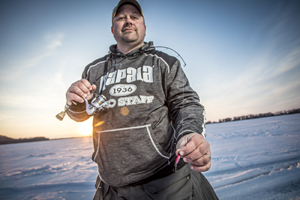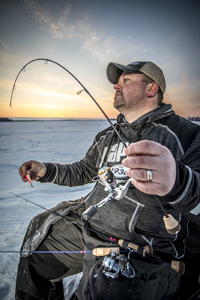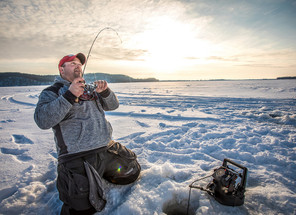Posted by Chris Larsen on 8th Oct 2019
How To Choose An Ice Fishing Rod - Fish House Nation Podcast Episode #3
We recently discussed choosing an ice fishing rod with Joel Nelson. Joel is an avid ice angler and outdoor communicator. You can find more about Joel and his fishing and hunter pursuits at JoelNelsonOutdoors.com
We’re hearing a lot about custom rods these days. What is the difference between a custom rod and something you might find in a retail store?
“Very few rods these days are truly custom. I guess it comes back to how far back in the build process you want to go to call it custom. Does custom mean you get a blank from somewhere but you do your own wraps or they do their own special twist on it? Their own painting or their own threads? Or does custom really mean we’re going to start from a single sheet of Tyvek looking carbon material and we’re going to wrap it over a steel rod mandrel and develop the blank, develop everything? Paint it, dip it, the whole nine yards? The only manufacturer out there that I know that is truly building from scratch is St. Croix.”
How do you find the perfect ice fishing rod?
What do you fish for? And then start breaking it down and really get into the weeds. If you look at the open water rods market, for years now we’ve been customizing every angle about how we fish. Are you jigging? What kind of jigging are you doing? Are you pitching jigs out from the boat? Are you fishing directly below the boat vertically? Are you fishing deep water with heavier jigs? Are you fishing with light jigs? Are you fishing for panfish or walleyes? That level of detail from the open water side is now starting to show itself on the ice rod side. You need to take a long hard look at the types of fishing you do for what species, what depth, and what lure. And also where you’re fishing. Are you fishing outside? Are you fishing inside? You’re going to have rod length considerations to deal with there. It really starts with a full-on analysis of what you do, where you do it, and how you do it. From there, the recommendations come easier.
What is the best rod for ice fishing panfish like crappies and bluegills?

In panfishing today there are two main powers and actions. The first is a little more traditional. It’s a slightly stiffer rod it’s still a light power but an extra fast action. Tungsten has been the rage in panfishing. Tungsten with plastic and you’ve got the ultimate in attraction. A light power with extra fast action rod is going to do a really good job of making that plastic dangle and wiggle perfectly and give you a ton of control in the process. On the other side of the panfish realm, you’ve got a noodle rod. We’ve all heard the term noodle. What that is is a rod with a lot of forgiveness towards the tip. It’s a fiberglass section towards the rod tip that basically allows an angler to detect a bite via sight. You can watch that rod load up. You can watch a panfish tickle the end of it. But then when you go set the hook the back section of that rod is extremely stiff, meaning it goes from a ton of give to no give instantly. Those are the kinds of powers and actions if your a panfish angler that I would consider. A lot of it comes down to how do you detect a bite. Do you look at the rod tip and do you want that extra forgiving tip? It’s almost like a bite indicator. Or do you like more control of your lure and you like feeling the bite versus seeing it?
What is the best ice fishing rod for walleye fishing?
I like to fish for walleyes in two different settings and scenarios. The first is open ice. I can never get enough of that, it’s awesome. Big water. Drilling lots of holes. Dropping spoons all over the place, Jigging Raps perhaps. In that case, I’m fishing outside and I’m going to be standing up. A slightly longer rod in medium light or medium power but fast and extra fast action are really beneficial for putting a good hook to a walleye, especially bigger fish. They have hard mouths and a lot of times spoons are small and hooks are small so to drive that hook home that’s what I’m looking for, a longer 32”+ rod. Maybe 34” or 36” or longer. If I’m fishing primarily inside with a 36” rod, I may set the hook and nail the furnace or a ceiling fan. We’ve gotta shorten that stick up a little bit, something like 28”. As a general rule, I’m trying to fish with as long a rod as possible given any circumstance, whether I’m in a portable, a permanent, or outside.
What is the best ice fishing rod for big fish like pike and lake trout?
Your presentation is going to bear what kind of rod your fishing. If you’re fishing for lakers up in the Canadian Shield, you’re using 1-½ ounce or 2-ounce airplane jigs you need a rod that can stand up to that amount of weight so that the rod isn’t sloppy and you can maintain control of the bait. With pike, a lot of times, you don’t need that much stiffness in a rod because you’re fishing lures that are slightly lighter. In that respect, a good spinning rod, as long as possible… again, as long as possible. The bigger the fish, the longer the head shake. The more chance they have to put slack in the line. I’m looking for a long rod in a medium heavy up to a heavy power with that fast or extra fast action. That said, if your fishing in slammers or automatic hook setters, you want a rod that’s a little more forgiving. Something fiberglass or slower action. It’s hard as you can tell. I’m talking a lot about the different scenarios and really that’s what it comes down to. What scenario do you fish, with what lures, and what species and depth?
Does the depth of water matter when it comes to ice fishing rods?
The presentation has a lot to do with it. Typically, the deeper the water, the heavier the lure or jig. In which case, you need a heavier power on the rod.
Is having a rod for each situation really necessary?
People may say, “Hey, aren’t you going a bit overboard? I’ve fished with the same rod for walleyes my whole life.” Perhaps. To each their own. Get as specific as you want. I liken it to a screwdriver. I can use a screwdriver as a hole punch. There are Phillips head screwdrivers and flathead screwdrivers. But the right sized screwdriver for the right application is going to do a much better job. The more specific you get with your tools, typically the better end-user experience you’re going to have when you fish with it.

If you spend enough time on the water you’re going to encounter days where it doesn’t matter what you’re fishing. You can catch them on anything. It doesn’t matter. But you’re also going to encounter a lot of days, especially towards midwinter when it gets tougher where the right lure with the right power, length, and action… it’s not just about comfort anymore. It’s not just about preference anymore. It’s literally about detecting more bites and catching more fish. Because you have a superior system to detect bites, to present the lure, to target the species at the depth that they’re at with the lure you’re fishing. Those are little tweaks. It’s not just academic at that point. It’s actual.
What is the best length for an ice fishing rod?
It’s very common to see 28” to 32” across the board. If I’m in a hardhouse or my Otter portable, I’m looking in that ballpark. I lean toward 32” when I can get away with it. Extra length gives you more leverage on a bigger fish, allows more leverage for head shakes, and keeps that line tight in those situations. When I’m out on the open ice, longer is always better. The biggest hampering to length is rod cases. A 38” or 39” rod fits just inside most 40” rod cases. In some instances, it would be nice to go even longer, especially for big pike and lake trout. I see a trend in longer rods on ice.
How many rods should the average ice angler have?
It really depends on how many species and situations they fish. I’m fishing for panfish one week and walleye the next. And varying kinds of panfish. Sometimes it’s bluegills in shallow weeds then I’ll go fish crappies in open basins. I’ve got two rod boxes. I stuff them full. That’s 10 to 12 rods but that’s extreme. I don’t think your average angler would ever want to own that many rods. That’s a lot to maintain and keep up. That said, it’s like a full toolbox. I keep going with this analogy because the more tools you have the better chance you’re going to match the right presentation with the right rod. But I think an angler who is an avid panfish angler can get away with two rods, maybe three depending on how many different looks they wanted. In some respects, it’s an expensive luxury to have. But to have another rod with another presentation rigged up and ready to drop on that same fish, sometimes that’s going to get you 90% of your bites… the second drop with different bait. If you’re fishing a bunch of different species and going all over, 10 to 12 rods isn’t out of the question. But if you’re fishing primarily a single species or a single type of fishing on the same lake, two or three rods might be all you need.
Anything else?
Reels are important too, as well as the line. It’s all a system that works together. The worst thing you could do is spend an unbelievable amount of money on the fanciest custom rod on the planet but then find a junker reel like an old egg beater that’s heavy and weighs the thing down and it’s poorly balanced. Spend some time researching your reels. Find reels that are lightweight. If you’re going to buy up to a custom rod, make sure you pair it with the right stuff because it’s really going to make the rod’s performance suffer.
If you’re ever confused about what rod to purchase, St. Croix Rods has a descriptor on their website that lays out the perfect rod for the job. Whether it’s a St. Croix that you end up buying or not, you can always go to that site and get the right rod recommendation at the right length, the right power, and the right action for the job. That’s helped me personally learn from the benefit of other anglers to figure out what rod I should be fishing and when.
Looking for fish house accessories for ice season? Shop our store by clicking here.
Thanks to Joel Nelson for the interview. You can listen to the entire interview by clicking the audio player below.
You can follow Joel Nelson on Instagram here. While you’re on Instagram, give Fish House Nation a follow as well!

